Table of Contents
Whitney Blankenship
Content Marketing Manager
Reading Time: 9 minutes
Identifying, attracting, and retaining the right kind of customers is key to the success of any business, so it’s crucial to have the right tools on hand to maximize your potential.
The best way to learn about your customers’ preferences and behavior is through customer analytics, which helps to visualize your customer data and allows you to provide personalized, relevant messaging at exactly the right times.
In this article, we’re going to look at some of the best customer analytics software, learn exactly how it works, and find out how you can use your customer data to implement things like omnichannel marketing and highly personalized automated messaging.
Why is this important? According to our Ecommerce Statistics Report, automated messages can dramatically increase your customer engagement and overall revenue, accounting for a full 29% of email orders from just 2% of total email sends!
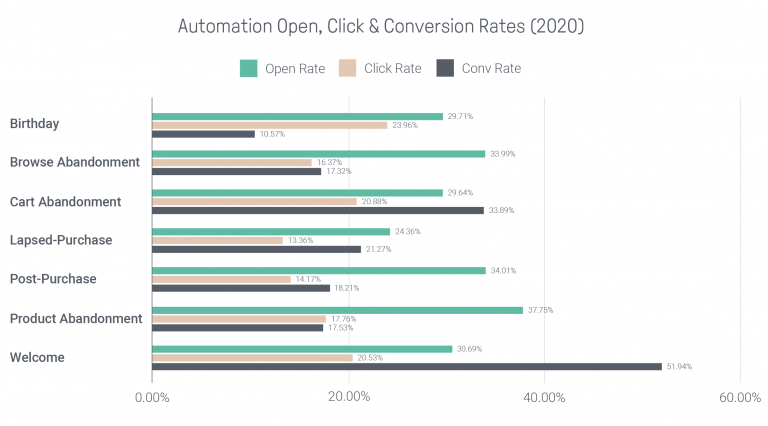
But first, let’s take a closer look at what customer data analysis is.
What are Customer Analytics?
Customer analytics is all about collecting, analyzing, and visualizing historical customer data and behavior. Among other things, you can leverage your customer data to do things like:
- Create smart audience segments for more relevant messaging
- Drive acquisition, sales, and retention strategies
- Improve product development by predicting future outcomes
Today, customer analytics comes in the form of software, which ecommerce retailers and marketers can use to automatically capture customer data in real-time. This data is then processed to provide unique insights into users’ shopping behaviors, tracking things like average spend, most valuable customers, customer retention, and much more.
You’ll also be able to visualize your customer journey and build individual customer profiles, gaining even deeper insights into each and every customer that has visited your store.
How can you use customer analytics to nail your omnichannel strategy? Check out The Complete Guide to Omnichannel Marketing Automation for more info.
Why Should You Use Customer Analytics?
In a word—personalization. Today’s consumers have come to expect tailored experiences that cater to their own unique needs and preferences, with 91% saying that they are more likely to shop with brands who provide relevant offers and recommendations.
However, with 55% of marketers saying that they don’t have sufficient customer data to implement effective personalization, despite 83% of consumers being quite willing to share their data to create a more personalized experience, there is clearly a gap between expectations and reality.
Customer analytics software bridges this gap by smoothly and ethically enabling the collection of customer data, while empowering marketers to provide the personalized experiences that consumers demand. When you’re able to easily identify potential, active, and lapsed customers and segment them into various categories based on their demographics and behavior, you can proactively reach out to them with unique messaging such as personalized recommendations and special discounts, dramatically increasing your chances of conversion.
With 58% of enterprises witnessing a significant rise in customer loyalty and retention due to customer analytics, it has become a necessary part of any serious retailer’s strategy.
How Do Customer Analytics Work For Ecommerce?
Customer analytics can be broken up into three broad categories—data collection, data analysis, and making decisions based on results. Let’s look at these categories a little closer and check out some real-life examples in ecommerce.
1. Collecting and Storing the Right Kind of Data
Ecommerce retailers looking to personalize their marketing should first be looking to collect identity data like contact details and preferences. With this information, you can begin to build a comprehensive customer profile and easily track their shopping behavior, preferred channels, interest in various offers, and so on.
The best way to openly and ethically collect customer data is by getting website visitors to sign up for your subscriber list. You can do this by offering dynamic sign-up forms on your website, creating dedicated landing pages for gaining new subscribers, or offering lead magnets—valuable resources such as free ebooks, courses, or events in exchange for contact details.
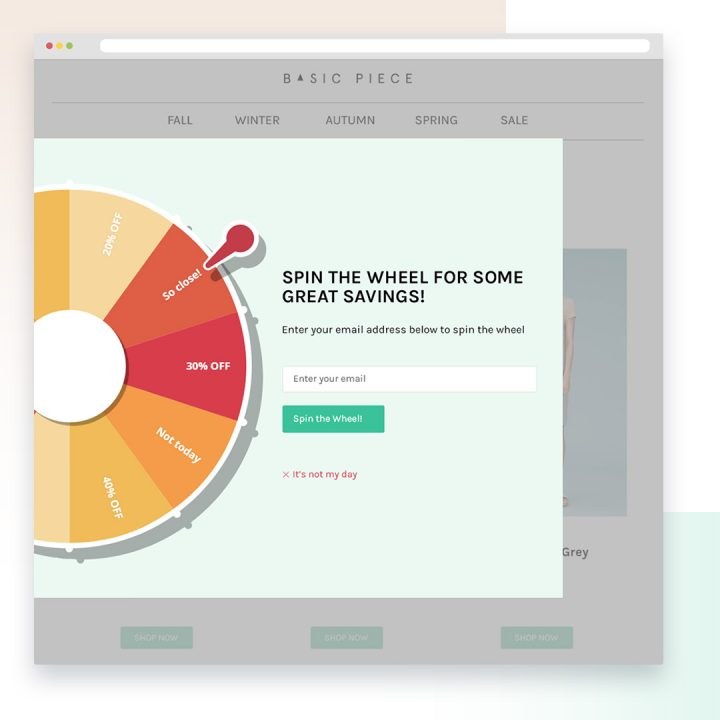
A well-stocked and healthy subscriber list is one of the most valuable assets you will have as an ecommerce retailer. It allows you to reach out with automated messaging across multiple channels when users abandon their carts, for example, and reengage with customers who haven’t purchased for a while.
Make sure that your marketing platform supports an intelligent, ecommerce-focused segmentation of your customer data. This means that contacts are automatically sorted into smaller, targeted categories based on what they’re buying, their average order value, their purchase recency, where they are buying from, on what kind of device, and so much more. This way, you can send highly relevant messages with recommendations and deals that you know that they want and appreciate.
2. Analyzing Your Customer Data
The classic means of website data analysis allows you to track page visits, search queries, bounce rates, and even show you how to analyze the customer journey.
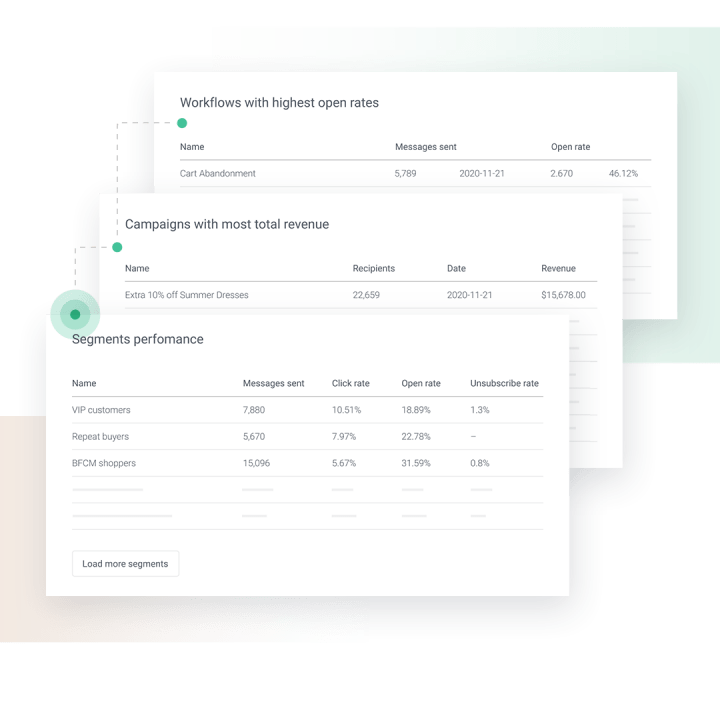
To better understand the decision-making process of customers when they interact with your online store, you should be aiming to answer questions such as:
- Which channels are driving the most conversions?
- Which CTAs do certain types of customers click on, and which do they ignore?
- Where are the pain points in the transaction process?
- Where they are most likely to lose interest and leave?
There are multiple analytics tools available that can measure different aspects of your customer data. However, it’s always better to have all of your customer analytics in one place. This includes a big-picture, strategic view of your overall sales performance and ROI, as well as the performance of individual marketing campaigns, automation workflows, and channels.
Some marketing platforms will even include website tracking to show you exactly where users are clicking. These platforms often highlight behavioral and transactional data, audience growth trends, and other customer insights examples, precluding the need for more specialized tools.
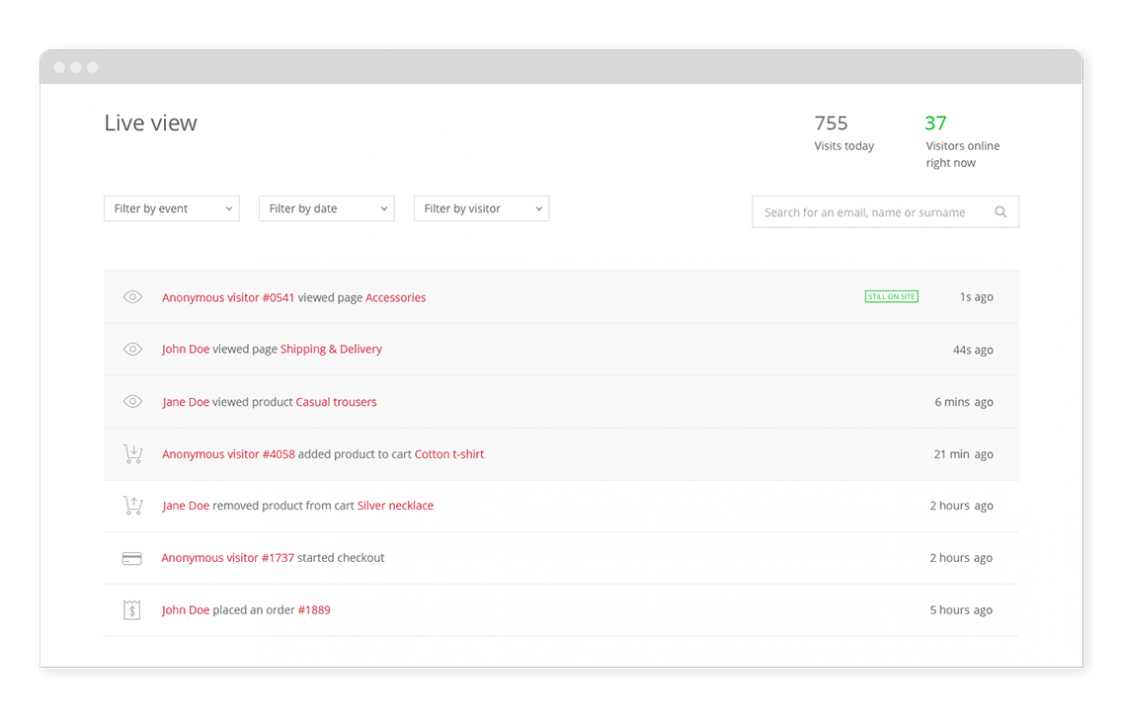
Check the analytics and reports capabilities of your marketing platform and see what they have to offer—excellent customer analytics can be a real game-changer so consider an upgrade if they aren’t up to scratch.
3. How to Implement Customer Analytics
So you’ve collected and analyzed your data, now it’s time to put your unique customer insights to good use. A good place to start is by incorporating it into strategies for customer acquisition, engagement, and retention.
Customer acquisition:
Now that you know who your ideal customers are and understand their preferences, you can consciously design acquisition strategies that are targeted specifically towards them. For example, if you know your ideal customer best responds to a certain kind of display ad, email campaign, or product recommendation, reusing those tactics you’ve discerned through data analysis will help you more easily and cost-efficiently acquire new customers.
This focus will reduce your marketing costs (you’re only reaching out to those that you know are interested) while increasing the relevance of your messages.
Customer engagement:
To effectively engage with your customers, you have to show that you understand them. Customers appreciate personalized recommendations and solutions to their needs, so use your customer profiles and carefully segmented data to engage them with content and offers that are exactly what they’re looking for, at exactly the right time.
Customer analytics is particularly important for implementing omnichannel marketing, which allows you to seamlessly reach out to customers across channels for an integrated shopping experience from the first touchpoint to the last.
If you can understand why customers are leaving your store or have stopped buying from you, then you’re on your way to developing predictive customer analytics. This means you can proactively reach out to at-risk customers (those who haven’t purchased for 30 days, for example) with special offers and discounts to entice them back into the fold before they churn.
What Software Should You Use for Customer Analytics?
For small and medium-sized businesses, a ready-to-use customer analytics tool that is designed specifically to meet the needs of ecommerce retailers is recommended. Let’s take a look at a few of the best available.
1. Omnisend
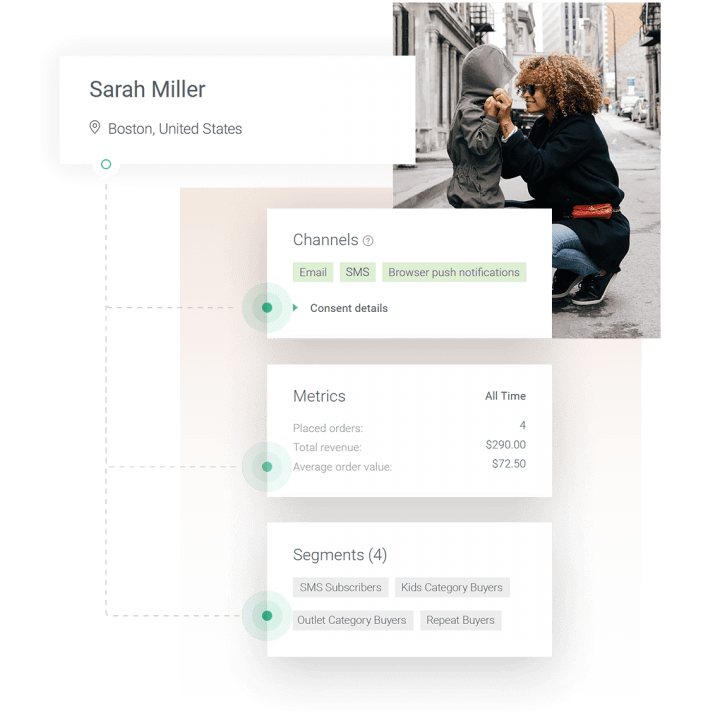
Ominsend is an omnichannel marketing automation platform that can provide everything a digital marketer needs to boost revenue and save valuable time—and this includes its comprehensive customer analytics.
Omnisend’s in-house analytics offers a combination of website tracking, behavioral, and transactional data to provide a unified, single-customer view. You can build a complete profile of each subscriber to fully understand their customer journey, understand which channels are performing best, track how much revenue your campaigns & workflows are driving, and much more.
You’ll also find all of the tools you need to optimize every step of the customer lifecycle. You’ll be able to create dynamic, interactive sign-up forms and landing pages that attract and capture the right kind of customers and data to your subscriber list.
Then you can reach out to them with automated omnichannel campaigns, which boast a purchase rate that’s 287% higher than single-channel campaigns, and capture lost revenue with things like product and cart abandonment. With your customer data intelligently organized into intuitive segments, your messaging is always going to be relevant, personal, and timely.
With personalized product recommendations and lapsed purchase campaigns designed to increase customer retention and reactivate lost customers, you can be sure that your customer analytics are always put to the best possible use.
Omnisend is a complete ecommerce marketing solution and is perfect for businesses who prefer to keep everything under one umbrella, rather than using and paying for a range of specialized tools.
Prices:
- Free – basic reporting
- The Standard Plan $16/mo – extra channels and features
- The Pro Plan $99/mo – advanced features and reporting
2. Google Analytics

Google Analytics is an essential tool that can track website data and provide detailed reporting on a whole host of customer metrics.
No other free tool comes close to the insights that Google Analytics can offer, with ecommerce-focused analytics that covers customer behavior, sales conversions, customer acquisition, channel performance, and much, much more.
And while it might seem a little overwhelming at first, there is a wealth of information at your fingertips to help you get the most out of your analytics. In no time, you’ll be creating in-depth audience reports, customer journey visualizations, segmenting data by audience type, and tracking search queries to really understand what your customers are thinking when they visit your online store.
Because of its sheer size and popularity, Google Analytics integrates seamlessly with most ecommerce platforms, meaning that it can be used to supplement your customer analytics if your marketing platform’s in-house analytics is not up to scratch.
Prices:
- Free
3. Kissmetrics
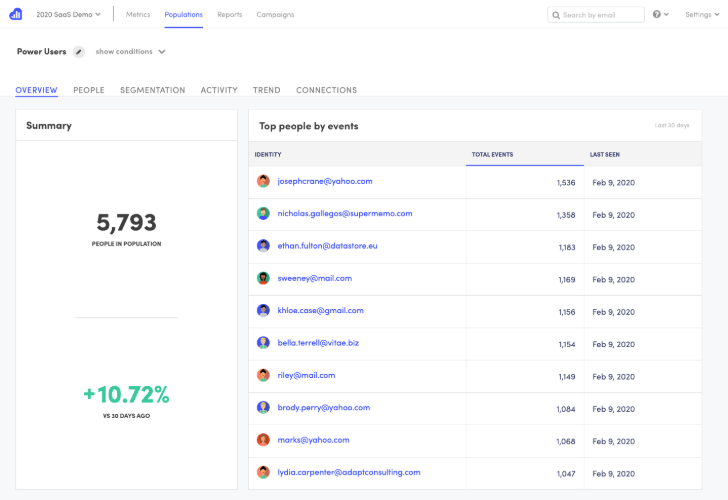
For a step-up from Google Analytics you could consider Kissmetrics, customer analytics software that specializes in visualizing the customer journey.
Kissmetrics aims to provide a more personalized view of customer data, allowing you to put yourself in your customers’ shoes and giving you real, actionable insights into their overall customer experience, motivations, and preferences.
You’ll be able to view your biggest spenders and find out what they have in common, check the growth rates of your first-time and repeat purchasers, see exactly how you acquired your best customers, and discover your average revenue per person. All of this information is instantly available via real-time reports, with all of your key metrics displayed on a customizable dashboard.
Kissmetrics is the perfect customer data analysis tool for those who have outgrown Google Analytics and are looking for a more focused solution. It is one of the best tools on the market for translating raw customer data into clear, actionable insights on which you can base your acquisition, sales, and retention strategies.
Prices:
- Silver: $299/mo
- Gold $499/mo
- Custom options on request
4. Hotjar
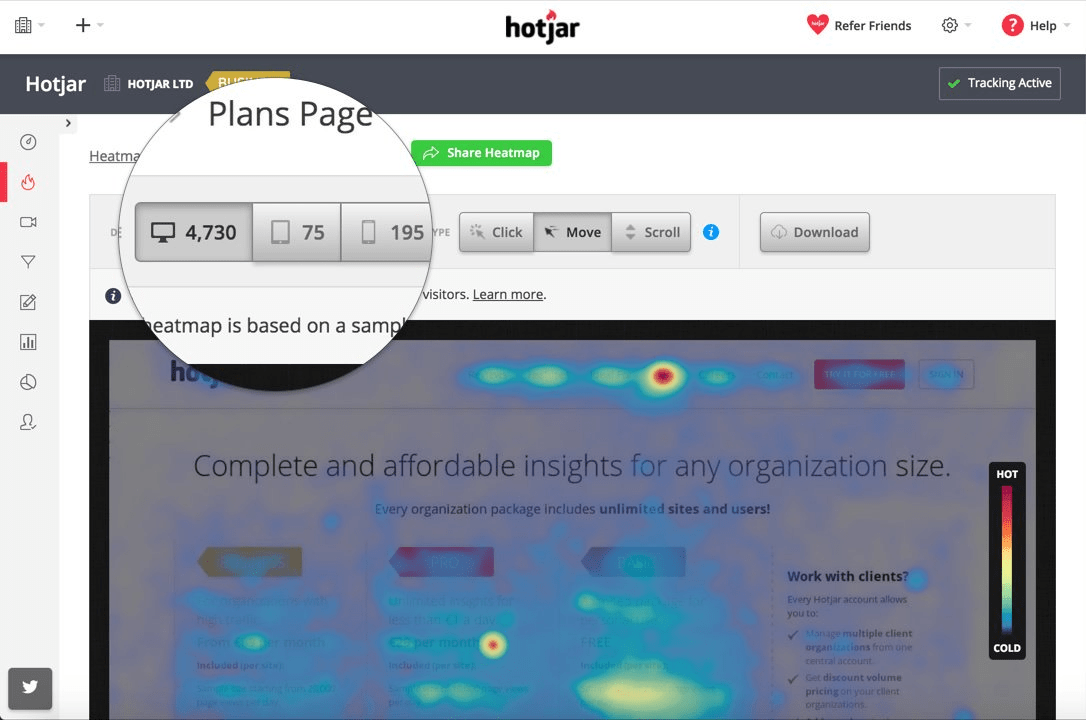
Hotjar is a visual customer analytics company that provides unique customer insights via its ‘heat map’ that shows which areas of your website are getting the most activity.
For example, let’s say you want to test out some different CTAs on your sign-up forms. You can easily see which one is the most effective by the amount of activity it gets over a certain period, giving you an insight into what resonates with your visitors.
There are many different types of heat maps to choose from, allowing you to see where users most often click, scroll, move from page to page, and on which devices they prefer to use. This kind of information helps you to understand exactly how customers interact with your page, find out what is working, and discover the points where they are most likely to drop off.
Hotjar is a niche tool that is second-to-none for website tracking. If your website layout needs to be optimized based on the unique needs and preferences of your customers, it is definitely worth checking out.
Prices:
- Personal Basic: Free
- Personal Plus: $29/mo
- Business: $89/mo
Wrap up
Whether your aim is to run promotional campaigns, boost your customer retention rates, or increase your overall ROI, customer analytics is central to your success.
Because it’s only by learning about your customers, getting to know their habits, needs, and preferences, that you’ll be able to offer them the kinds of experiences that they expect. This is great for them and it’s great for you too, as you can focus all of your energies on the right kind of customers, rather than wasting valuable time and resources on those who are unlikely to be interested anyway.
Every business is different and will prioritize different kinds of customer data. However, it is in the best interest of online retailers to find customer analytics companies that are built especially for ecommerce, so that you know that all your most crucial metrics will be covered. Omnisend does all of this and more, so consider getting yourself a free trial today and try it out for yourself!













